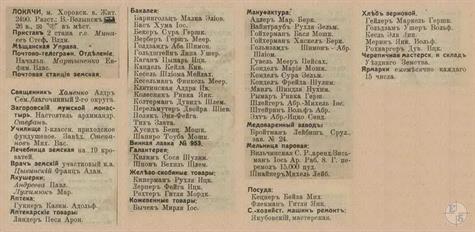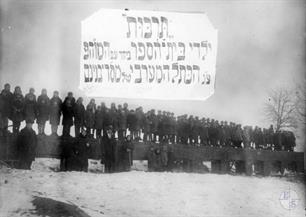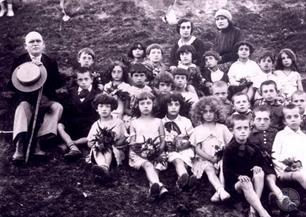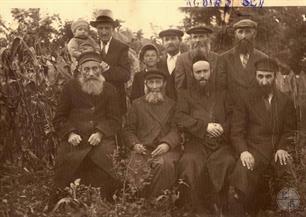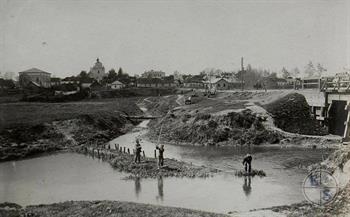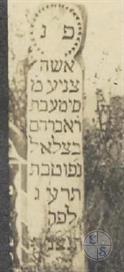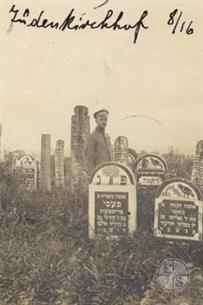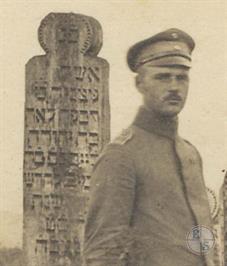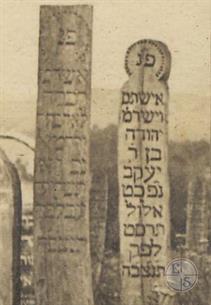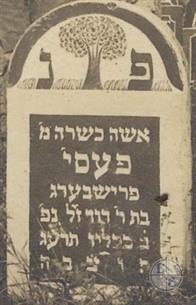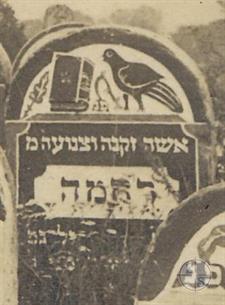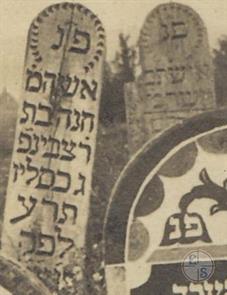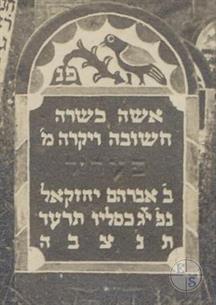Lokachi
Sources:
- Jewish encyclopedia of Brockhaus & Efron;
- Russian Jewish encyclopedia;
- The All South-Western Territory: reference and address book of the Kyiv, Podolsk and Volyn provinces. Printing house L.M. Fish and P.E. Wolfson, 1913;
- Virtual Shtetl. Lokachi;
- Encyclopedia of Jewish Life Before and During the Holocaust, vol. 2, eds. Sh. Spector, G. Wigoder, New York 2001, p. 746.
Photo:
- Wikipedia. Jewish cemetery in Lokachi
- Yad Vashem Collections. Lokachi
- Tomek Wisniewski. Wooden Tombstones from Jewish Cemeteries in Eastern Europe
- Tomek Wisniewski, Bagnowka. Lokacze
- Jewish encyclopedia of Brockhaus & Efron;
- Russian Jewish encyclopedia;
- The All South-Western Territory: reference and address book of the Kyiv, Podolsk and Volyn provinces. Printing house L.M. Fish and P.E. Wolfson, 1913;
- Virtual Shtetl. Lokachi;
- Encyclopedia of Jewish Life Before and During the Holocaust, vol. 2, eds. Sh. Spector, G. Wigoder, New York 2001, p. 746.
Photo:
- Wikipedia. Jewish cemetery in Lokachi
- Yad Vashem Collections. Lokachi
- Tomek Wisniewski. Wooden Tombstones from Jewish Cemeteries in Eastern Europe
- Tomek Wisniewski, Bagnowka. Lokacze
Lokachi, urban -type settlement (since 1940), former district center in the Volyn region. Founded in 1508. In the 16–18 centuries - the township of the Vladimir Powiat of the Volyn Voivodeship as part of the Commonwealth. From 1795 - as part of the Russian Empire. In the 19th - beginning of the 20th century - the township of Vladimir district of the Volyn province. In 1919–39 - as part of Poland, in 1939–91 - USSR.
In 1765, 907 Jews lived in Lokachi,
in 1847 - 1150,
in 1897 – 1730 (75%),
In 1921 - 1265 Jews (70.5%).
The earliest historical documents to mention Jews in Lokachi (Ukr. Локачі) date back to 1569. The local community developed under favourable conditions guaranteed by Lokachi’s status as a noble-owned private town.
Kahal in Lokachi was in the jurisdiction of the Vladimir Kahal.
There is a mention of Jews in Lokachi in 1588, when nobleman Kushgur Medunsky accused the bourgeois and Jews of Lokachi of having beaten him.
The local Jews was forced to flee during the Khmelnytsky Uprising (1648–1649), but the community was soon revived.
In 1704, Lokachi became the birthplace of Dov Ber, later known as the Great Maggid or Maggid of Mezritch (1704–1772). He was one of the greatest Hasidic leaders and the leading theoretician of the Hasidic movement.
In the 1st half of the 18th century, the rabbi in Lokachi was Shaul Lovenstam (later - the rabbi in Amsterdam).
In 1765, 907 Jews lived in Lokachi,
in 1847 - 1150,
in 1897 – 1730 (75%),
In 1921 - 1265 Jews (70.5%).
The earliest historical documents to mention Jews in Lokachi (Ukr. Локачі) date back to 1569. The local community developed under favourable conditions guaranteed by Lokachi’s status as a noble-owned private town.
Kahal in Lokachi was in the jurisdiction of the Vladimir Kahal.
There is a mention of Jews in Lokachi in 1588, when nobleman Kushgur Medunsky accused the bourgeois and Jews of Lokachi of having beaten him.
The local Jews was forced to flee during the Khmelnytsky Uprising (1648–1649), but the community was soon revived.
In 1704, Lokachi became the birthplace of Dov Ber, later known as the Great Maggid or Maggid of Mezritch (1704–1772). He was one of the greatest Hasidic leaders and the leading theoretician of the Hasidic movement.
In the 1st half of the 18th century, the rabbi in Lokachi was Shaul Lovenstam (later - the rabbi in Amsterdam).
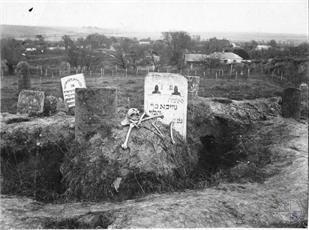 |
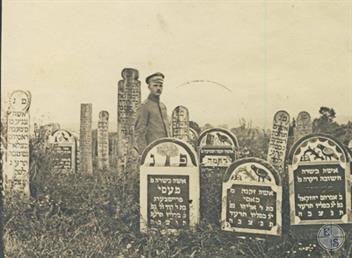 |
| Jewish cemetery, 1916. Photo took by German soldier. Cemetery was demolished in 1980s | Jewish cemetery with wooden tombstones, 1916. It can be seen that the tombstones were painted |
Volodymyr district, Volyn region
Lokachi continued to be a vibrant Hasidic centre in the 19th century. The local residents were followers of tzaddikim from Olyka, Turiisk, and Ruzhyn.
In 1885, 5 synagogues acted in Lokachi.
The rabbis in the town traditionally were the Lyudmir Hasides. Since the end of the 19th century, the rabbi has been Sholom-Yosef Faygenboym.
Most Jews made a living from crafts, as well as grain and wood trade.
In 1886, the pharmacy of Elberg worked.
In 1897, the community reached its peak size – 1,730 people, i.e. 74.9% of the town’s population.
In 1913, Jews owned the only warehouse of pharmacy products, a medovicular factory, both steam mills (one of them was on rent), a vehicle repair workshop, more than 40 shops (including 17 grocery, all 14 manufactory).
In 1885, 5 synagogues acted in Lokachi.
The rabbis in the town traditionally were the Lyudmir Hasides. Since the end of the 19th century, the rabbi has been Sholom-Yosef Faygenboym.
Most Jews made a living from crafts, as well as grain and wood trade.
In 1886, the pharmacy of Elberg worked.
In 1897, the community reached its peak size – 1,730 people, i.e. 74.9% of the town’s population.
In 1913, Jews owned the only warehouse of pharmacy products, a medovicular factory, both steam mills (one of them was on rent), a vehicle repair workshop, more than 40 shops (including 17 grocery, all 14 manufactory).
At the beginning of the 1st World War, a large number of refugee Jews arrived in Lokachi; at the same time, the cholera epidemic broke out.
In 1914, the soldiers of the Russian army arranged a Jewish pogrom in the town. Shimon An-sky, who visited the Lokachi in July 1915 as a representative of the “Jewish Committee for Assistance to Exiled”, appreciated the situation in the town as before the pogrom.
In the 1920s, the Tarbut school was opened. The Jewish library named after I.-L. Perets acted, which supported by the local Bund branch.
There were 4 synagogues (including 3 Hasidic).
In 1914, the soldiers of the Russian army arranged a Jewish pogrom in the town. Shimon An-sky, who visited the Lokachi in July 1915 as a representative of the “Jewish Committee for Assistance to Exiled”, appreciated the situation in the town as before the pogrom.
In the 1920s, the Tarbut school was opened. The Jewish library named after I.-L. Perets acted, which supported by the local Bund branch.
There were 4 synagogues (including 3 Hasidic).
In 1927, the Jewish Committee for Assistance to Orphans was created, and a Jewish youth club was later opened. The departments of the "ha-Shomer ha-Tsair", "he-Khalutz", "Beitar", "Mizrahi" acted.
German troops seized the town on 23 June 1941. They ordered the establishment of a Judenrat and introduced forced labour.
In October 1941, a closed ghetto was established in the town. On 13 September 1942, all its prisoners – 1,350 people, including refugees – were shot over previously dug pits. The perpetrators of the crime were the German SD and Ukrainian policemen.
German troops seized the town on 23 June 1941. They ordered the establishment of a Judenrat and introduced forced labour.
In October 1941, a closed ghetto was established in the town. On 13 September 1942, all its prisoners – 1,350 people, including refugees – were shot over previously dug pits. The perpetrators of the crime were the German SD and Ukrainian policemen.

- Home
- Shtetls
- Vinnytsia region
- Volyn region
- Dnipro region
- Donetsk region
- Zhytomyr region
- Zakarpattia region
- Zaporizhzhia region
- Ivano-Frankivsk region
- Kyiv region
- Kropyvnytskyi region
- Luhansk region
- Lviv region
- Mykolayiv region
- Odessa region
- Poltava region
- Rivne region
- Sumy region
- Ternopil region
- Kharkiv region
- Kherson region
- Khmelnytskyi region
- Chernihiv region
- Chernivtsi region
- Cherkasy region
- Crimea
- Synagogues
- Cemeteries
- Objects & guides
- Old photos
- History
- Contact
Jewish towns of Ukraine
My shtetl
My shtetl
Donate
Jewish towns of Ukraine
